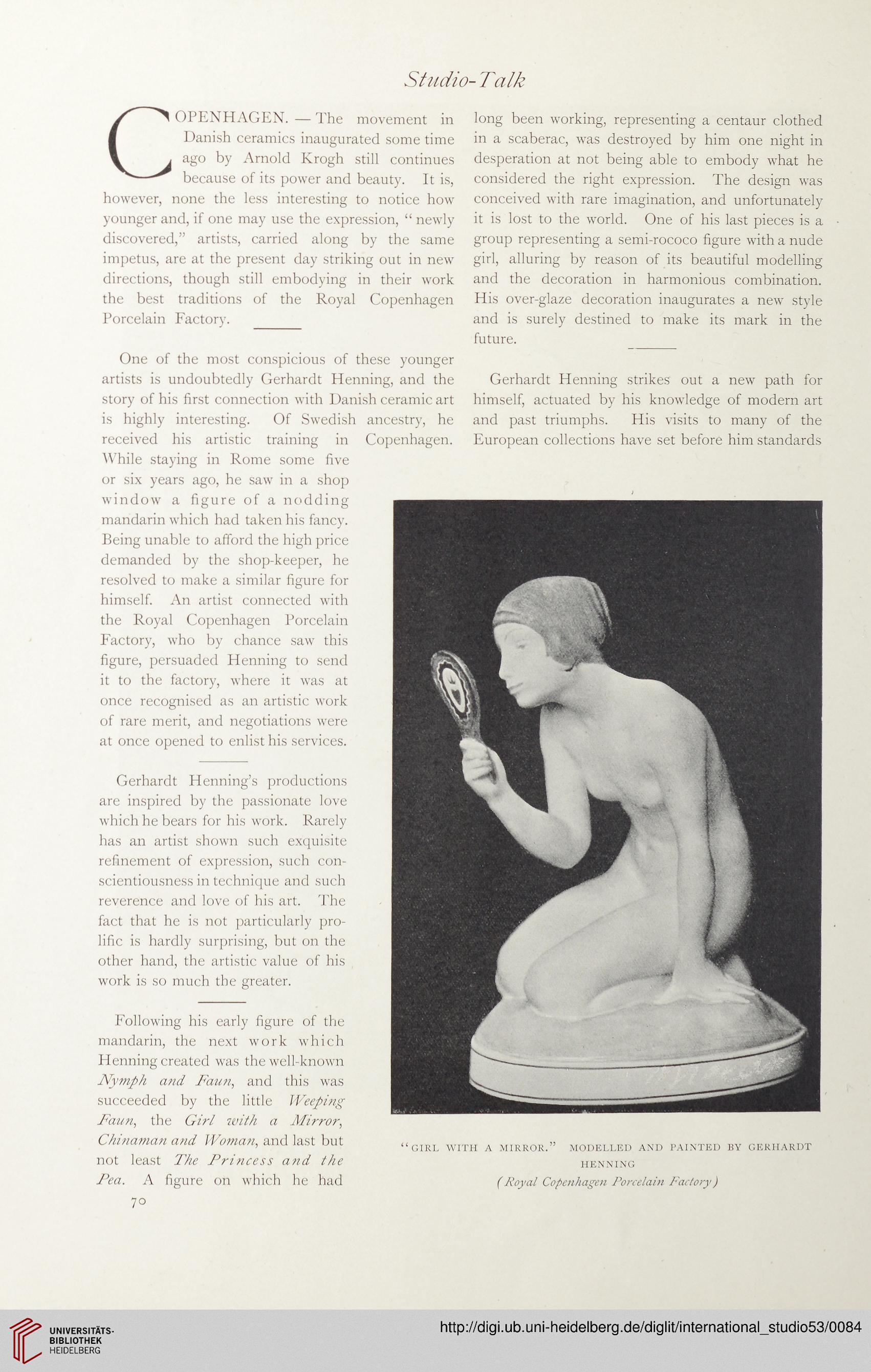Studio-Talk
COPENHAGEN.—The movement in
Danish ceramics inaugurated some time
ago by Arnold Krogh still continues
because of its power and beauty. It is,
however, none the less interesting to notice how
younger and, if one may use the expression, “ newly
discovered,” artists, carried along by the same
impetus, are at the present day striking out in new
directions, though still embodying in their work
the best traditions of the Royal Copenhagen
Porcelain Factory. _
long been working, representing a centaur clothed
in a scaberac, was destroyed by him one night in
desperation at not being able to embody what he
considered the right expression. The design was
conceived with rare imagination, and unfortunately
it is lost to the world. One of his last pieces is a
group representing a semi-rococo figure with a nude
girl, alluring by reason of its beautiful modelling
and the decoration in harmonious combination.
His over-glaze decoration inaugurates a new style
and is surely destined to make its mark in the
future.
Gerhardt Henning’s productions
are inspired by the passionate love
which he bears for his work. Rarely
has an artist shown such exquisite
refinement of expression, such con-
scientiousness in technique and such
reverence and love of his art. The
fact that he is not particularly pro-
lific is hardly surprising, but on the
other hand, the artistic value of his
work is so much the greater.
Following his early figure of the
mandarin, the next work which
Henning created was the well-known
Nymph and Faun, and this was
succeeded by the little Weeping
Faun, the Girl with a Mirror,
Chinaman and Woman, and last but
not least The Princess and the
Pea. A figure on which he had
“GIRL WITH A MIRROR.” MODELLED AND PAINTED BY GERHARDT
HENNING
f Royal Copenhagen Porcelain Factory)
ancestry, he
Copenhagen.
Gerhardt Henning strikes out a new path for
himself, actuated by his knowledge of modern art
and past triumphs. His visits to many of the
European collections have set before him standards
One of the most conspicious of these younger
artists is undoubtedly Gerhardt Henning, and the
story of his first connection with Danish ceramic art
is highly interesting. Of Swedish
received his artistic training in
While staying in Rome some five
or six years ago, he saw in a shop
window a figure of a nodding
mandarin which had taken his fancy.
Being unable to afford the high price
demanded by the shop-keeper, he
resolved to make a similar figure for
himself. An artist connected with
the Royal Copenhagen Porcelain
Factory, who by chance saw this
figure, persuaded Henning to send
it to the factory, where it was at
once recognised as an artistic work
of rare merit, and negotiations were
at once opened to enlist his services.
COPENHAGEN.—The movement in
Danish ceramics inaugurated some time
ago by Arnold Krogh still continues
because of its power and beauty. It is,
however, none the less interesting to notice how
younger and, if one may use the expression, “ newly
discovered,” artists, carried along by the same
impetus, are at the present day striking out in new
directions, though still embodying in their work
the best traditions of the Royal Copenhagen
Porcelain Factory. _
long been working, representing a centaur clothed
in a scaberac, was destroyed by him one night in
desperation at not being able to embody what he
considered the right expression. The design was
conceived with rare imagination, and unfortunately
it is lost to the world. One of his last pieces is a
group representing a semi-rococo figure with a nude
girl, alluring by reason of its beautiful modelling
and the decoration in harmonious combination.
His over-glaze decoration inaugurates a new style
and is surely destined to make its mark in the
future.
Gerhardt Henning’s productions
are inspired by the passionate love
which he bears for his work. Rarely
has an artist shown such exquisite
refinement of expression, such con-
scientiousness in technique and such
reverence and love of his art. The
fact that he is not particularly pro-
lific is hardly surprising, but on the
other hand, the artistic value of his
work is so much the greater.
Following his early figure of the
mandarin, the next work which
Henning created was the well-known
Nymph and Faun, and this was
succeeded by the little Weeping
Faun, the Girl with a Mirror,
Chinaman and Woman, and last but
not least The Princess and the
Pea. A figure on which he had
“GIRL WITH A MIRROR.” MODELLED AND PAINTED BY GERHARDT
HENNING
f Royal Copenhagen Porcelain Factory)
ancestry, he
Copenhagen.
Gerhardt Henning strikes out a new path for
himself, actuated by his knowledge of modern art
and past triumphs. His visits to many of the
European collections have set before him standards
One of the most conspicious of these younger
artists is undoubtedly Gerhardt Henning, and the
story of his first connection with Danish ceramic art
is highly interesting. Of Swedish
received his artistic training in
While staying in Rome some five
or six years ago, he saw in a shop
window a figure of a nodding
mandarin which had taken his fancy.
Being unable to afford the high price
demanded by the shop-keeper, he
resolved to make a similar figure for
himself. An artist connected with
the Royal Copenhagen Porcelain
Factory, who by chance saw this
figure, persuaded Henning to send
it to the factory, where it was at
once recognised as an artistic work
of rare merit, and negotiations were
at once opened to enlist his services.




